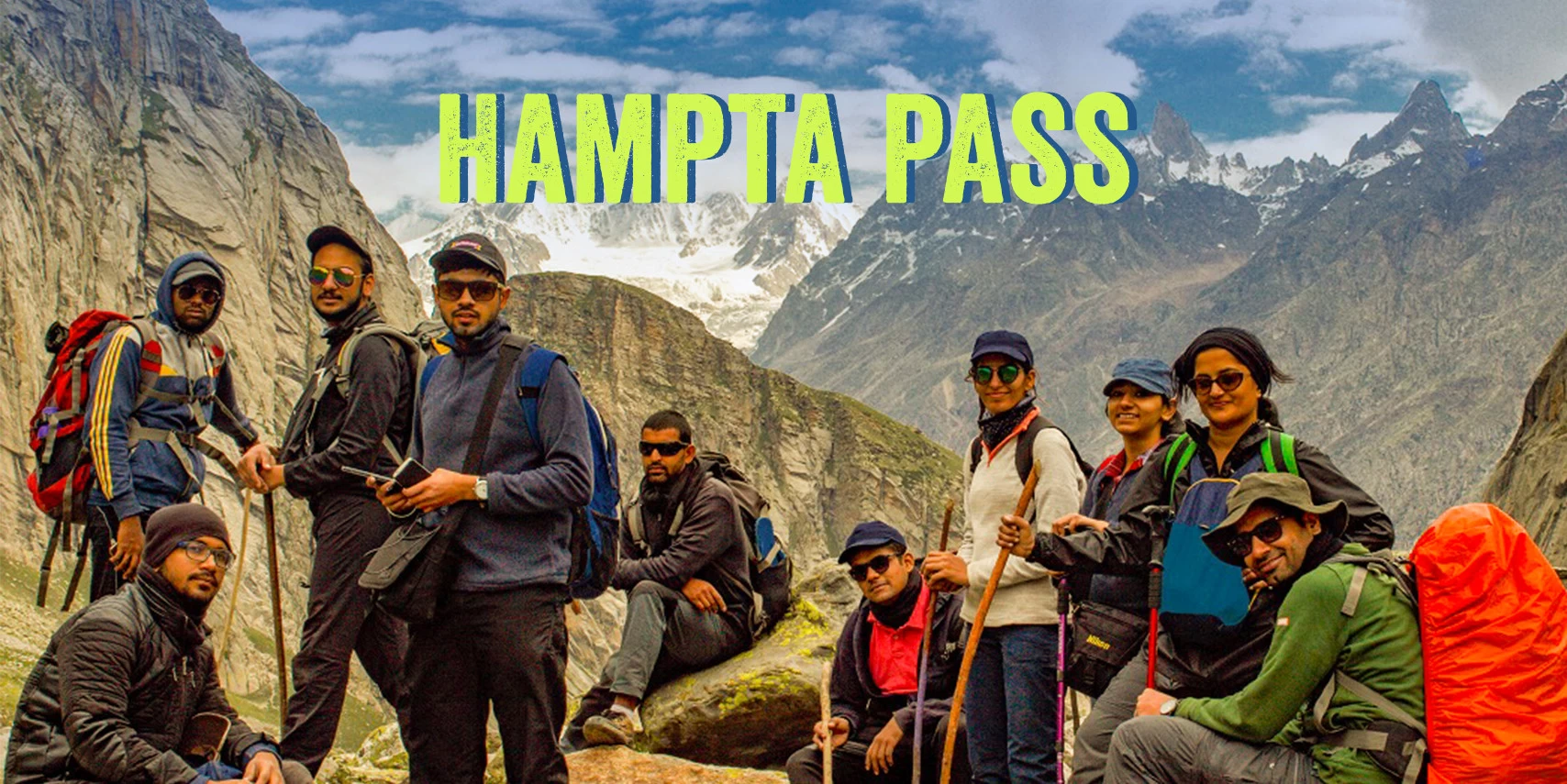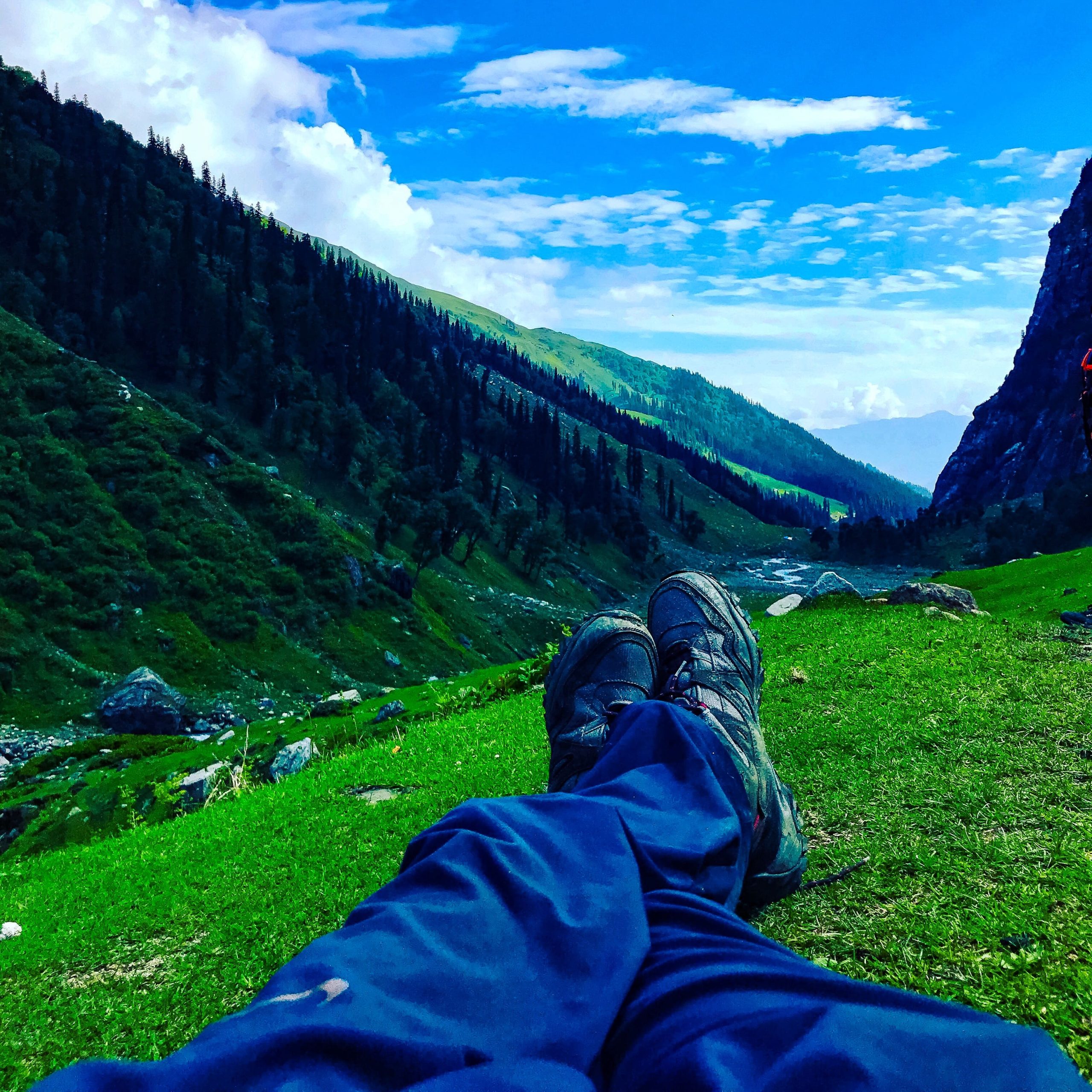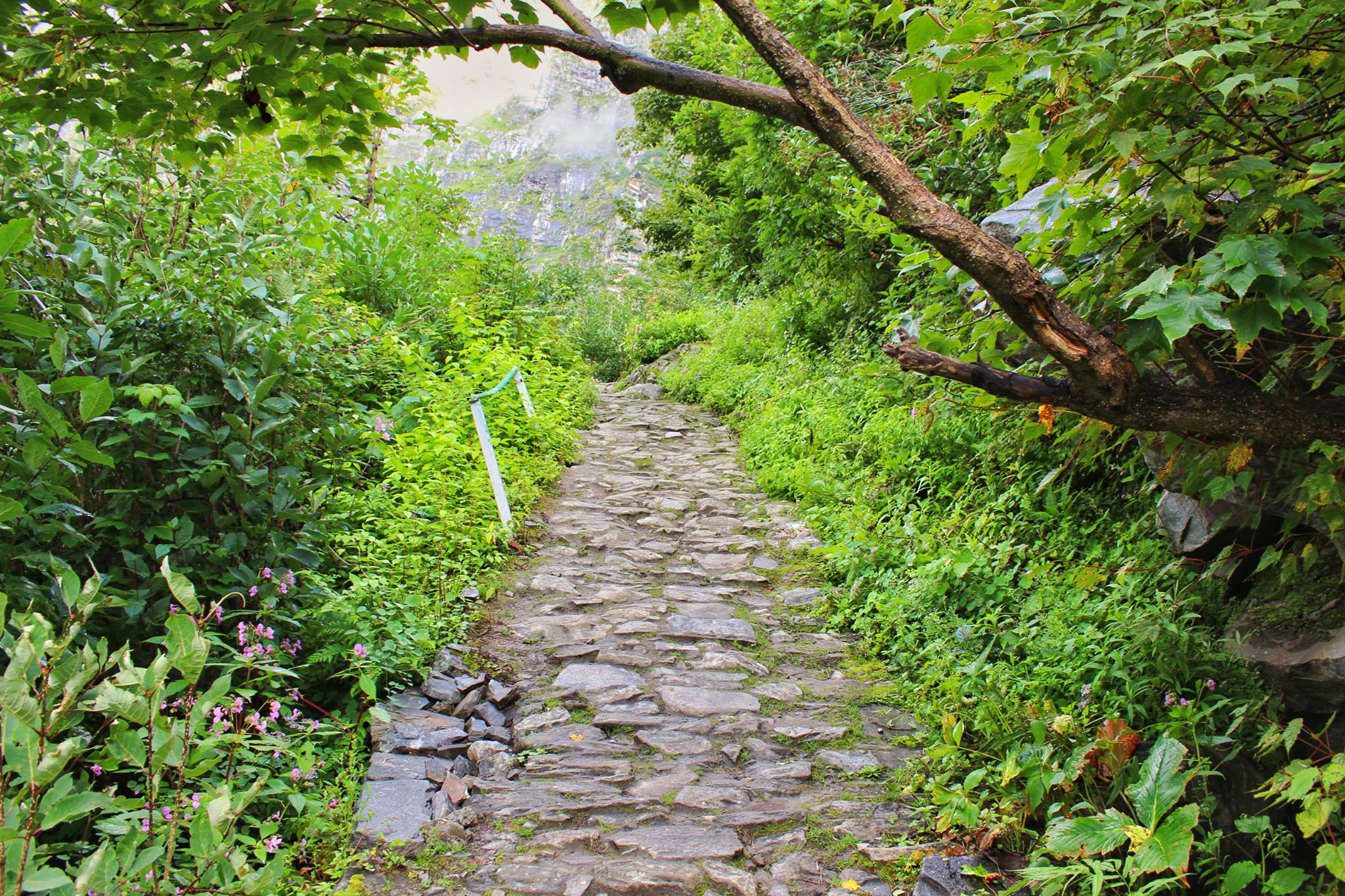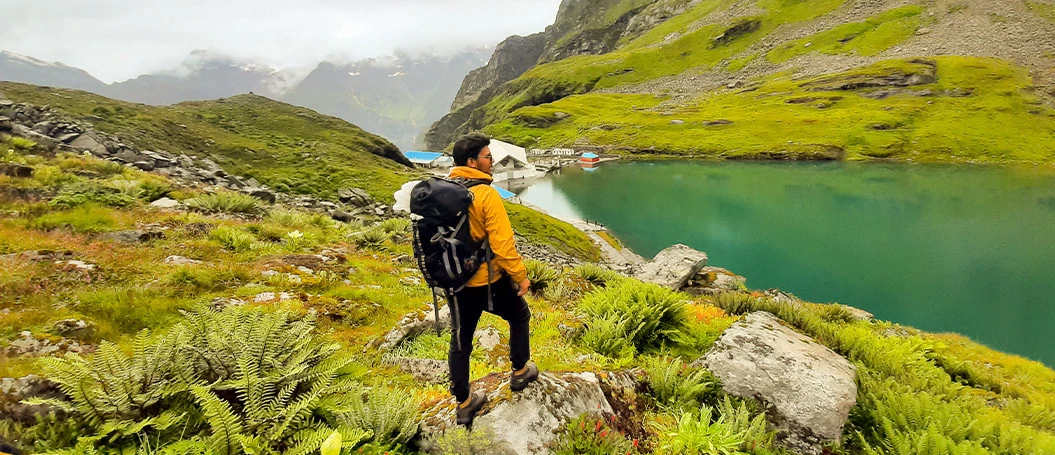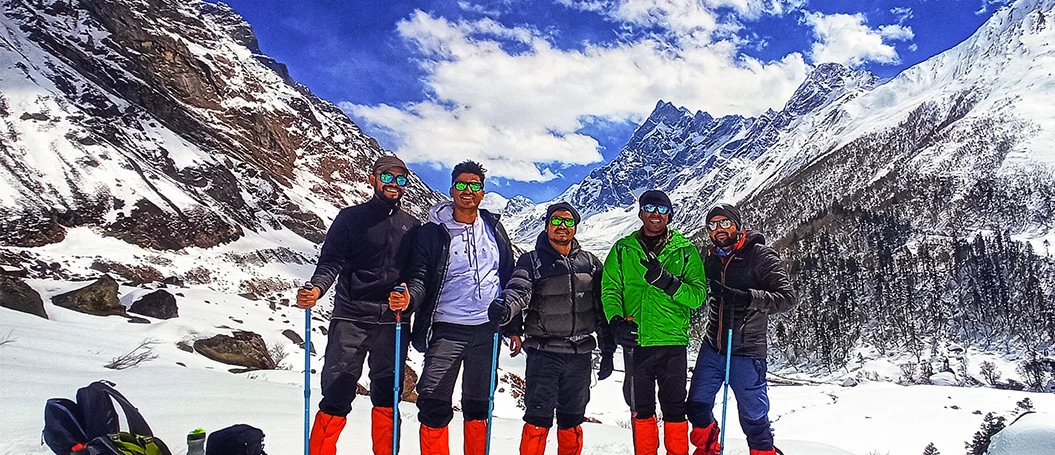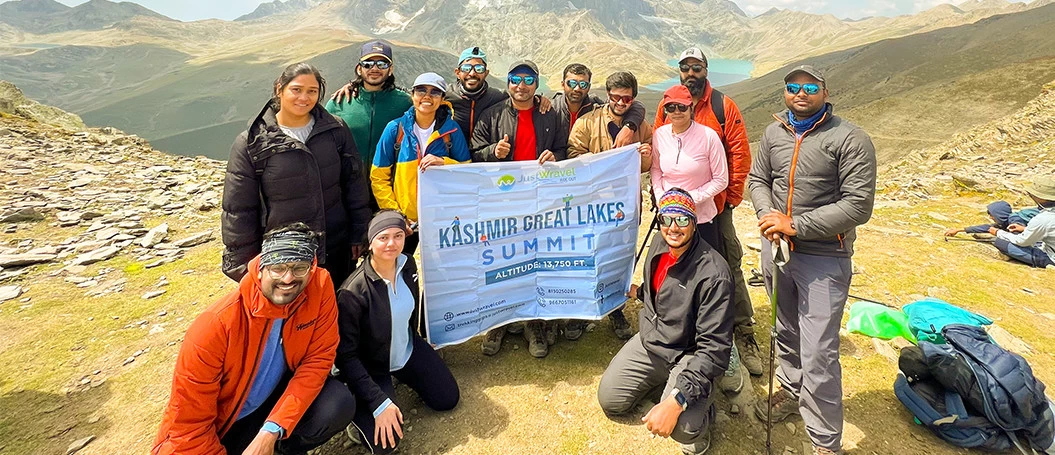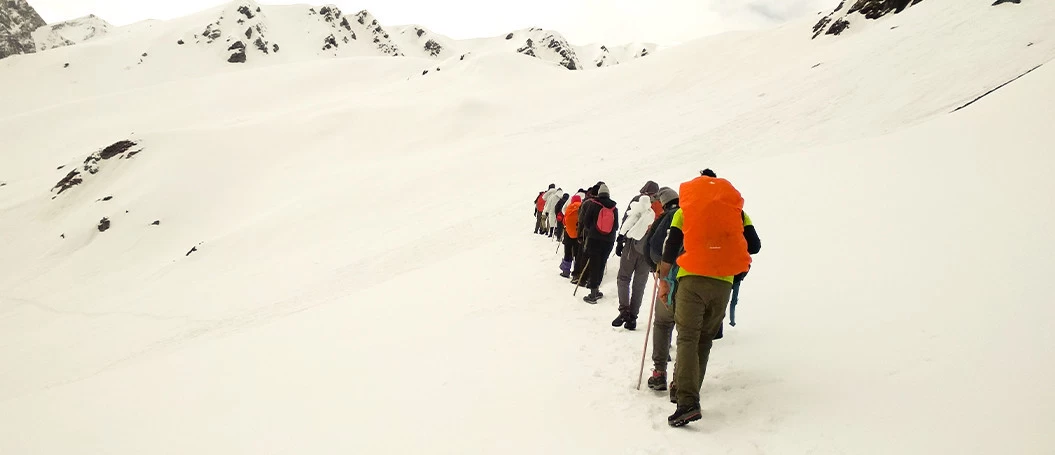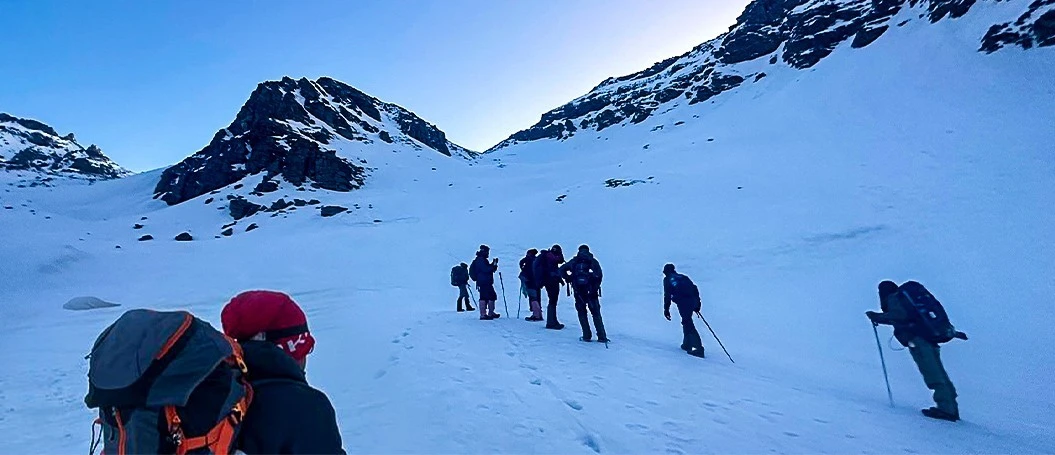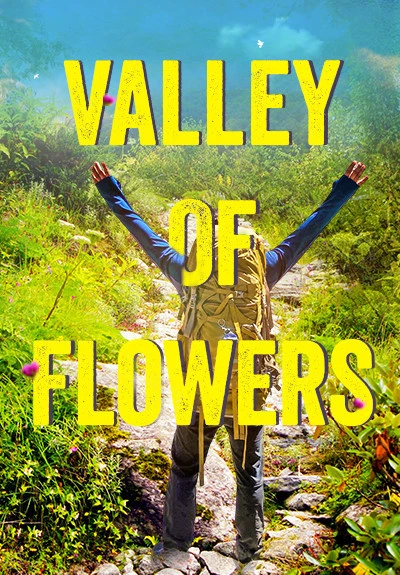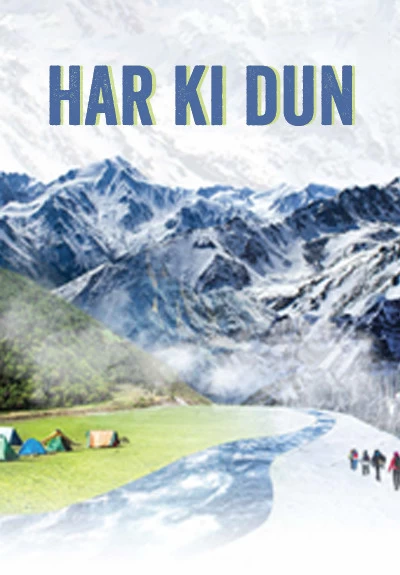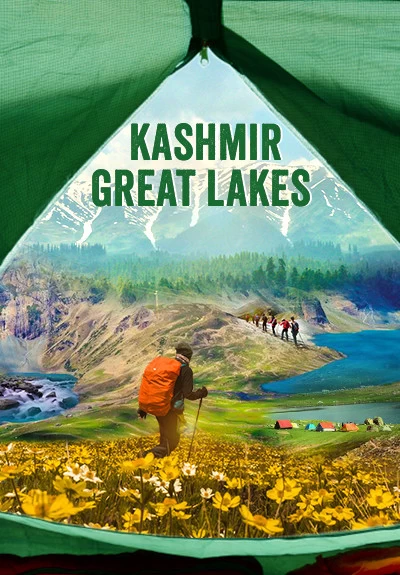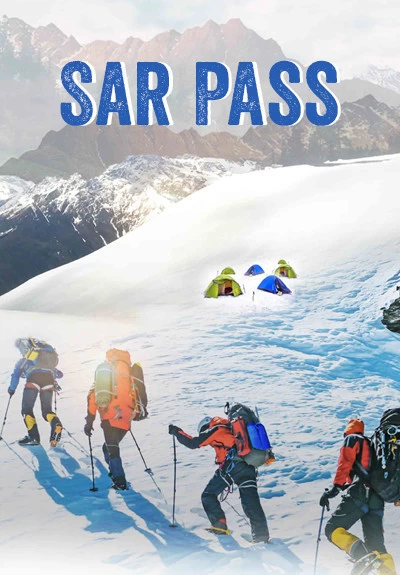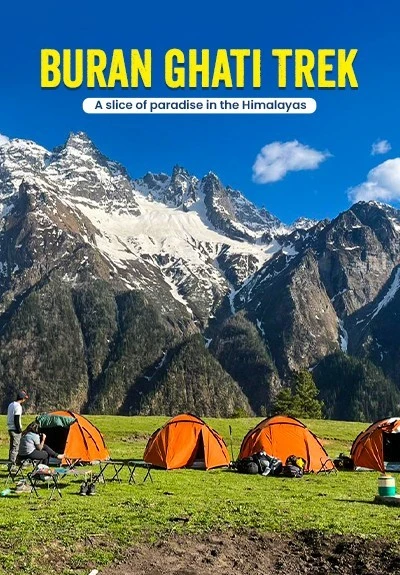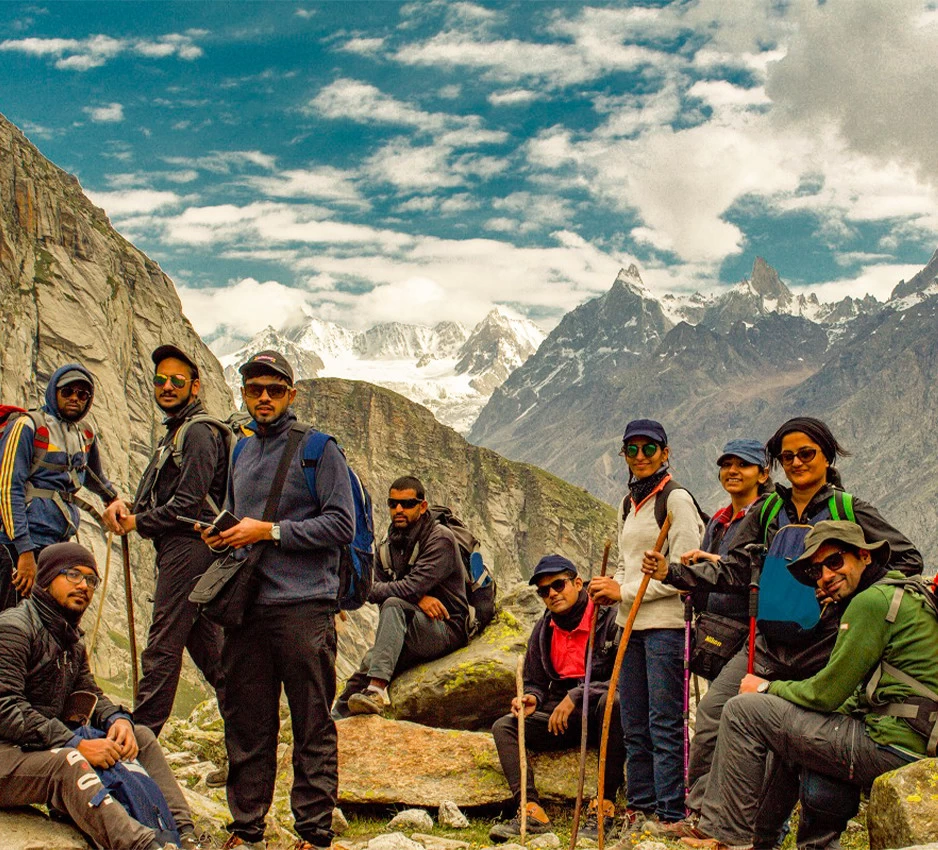
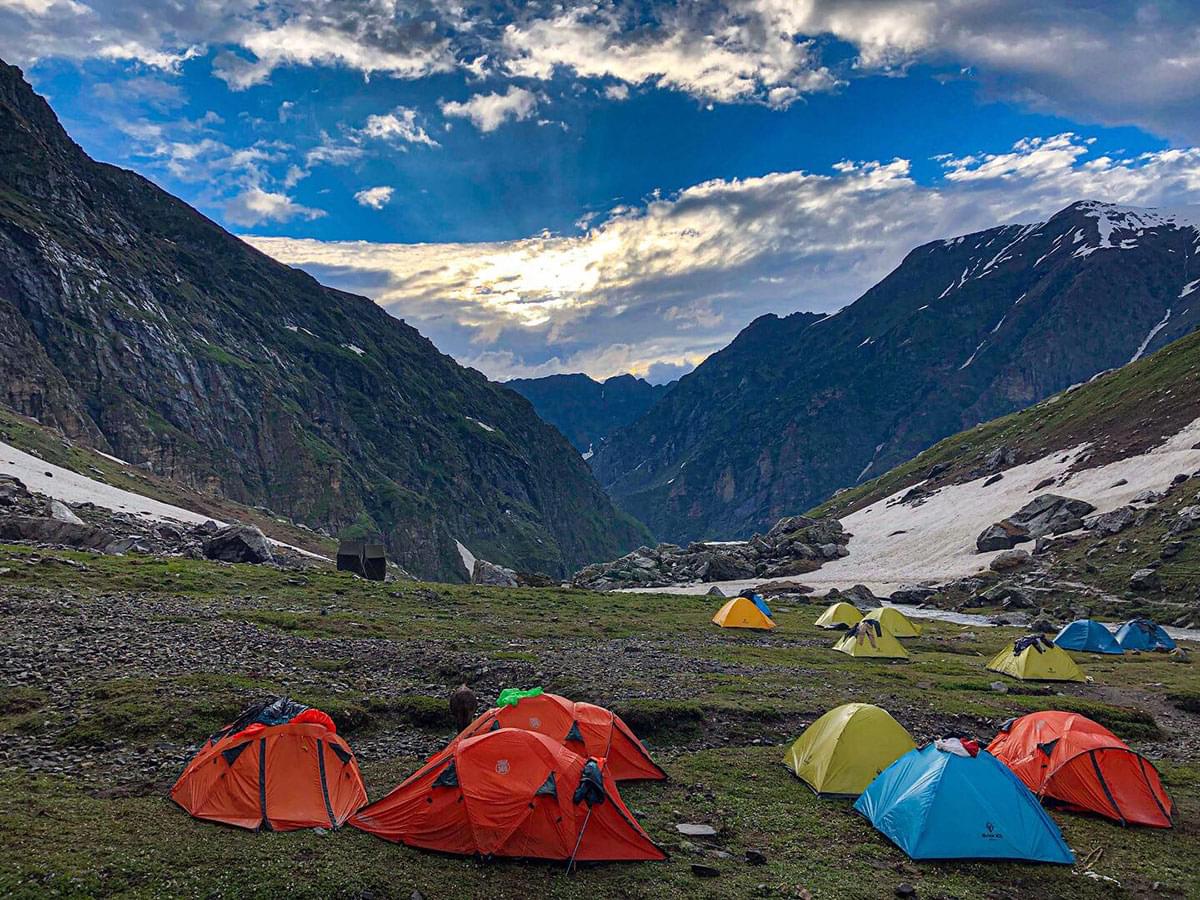
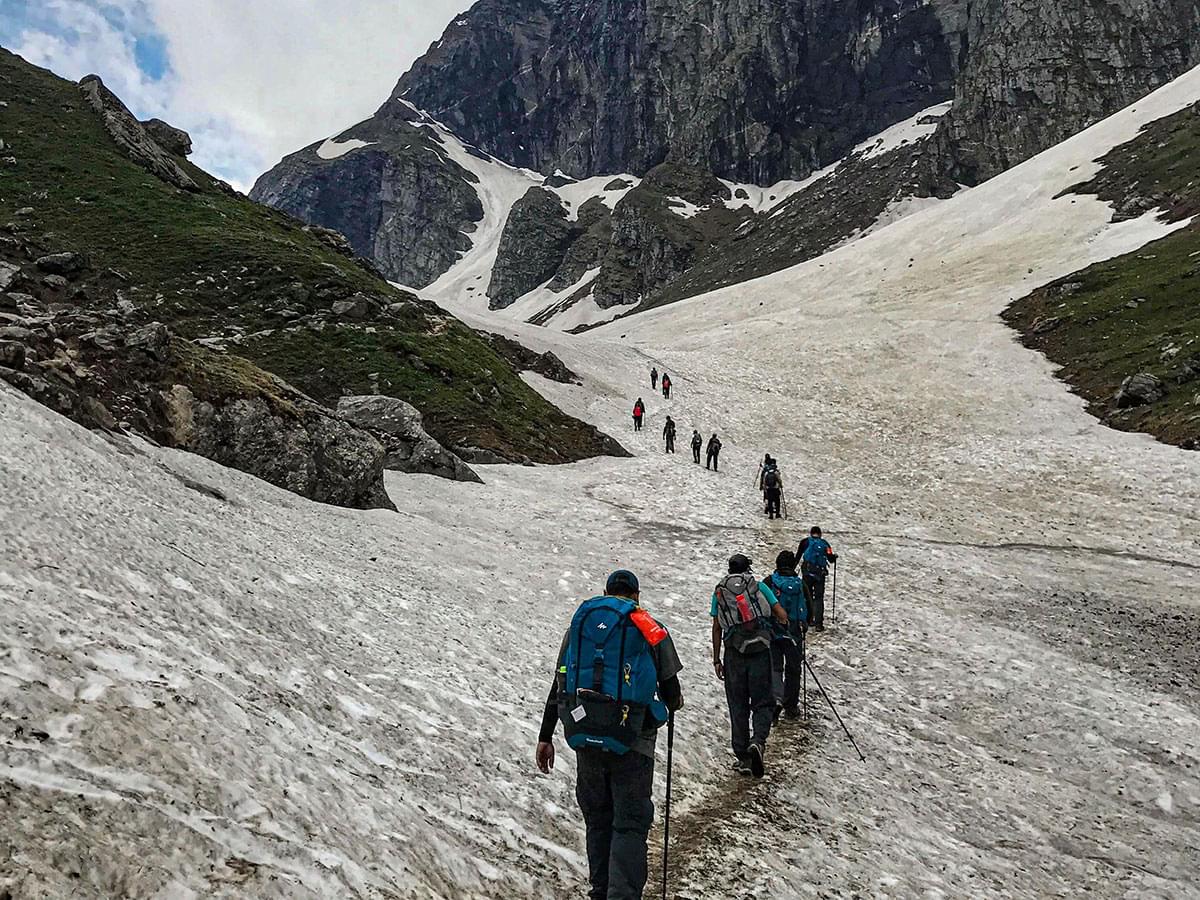
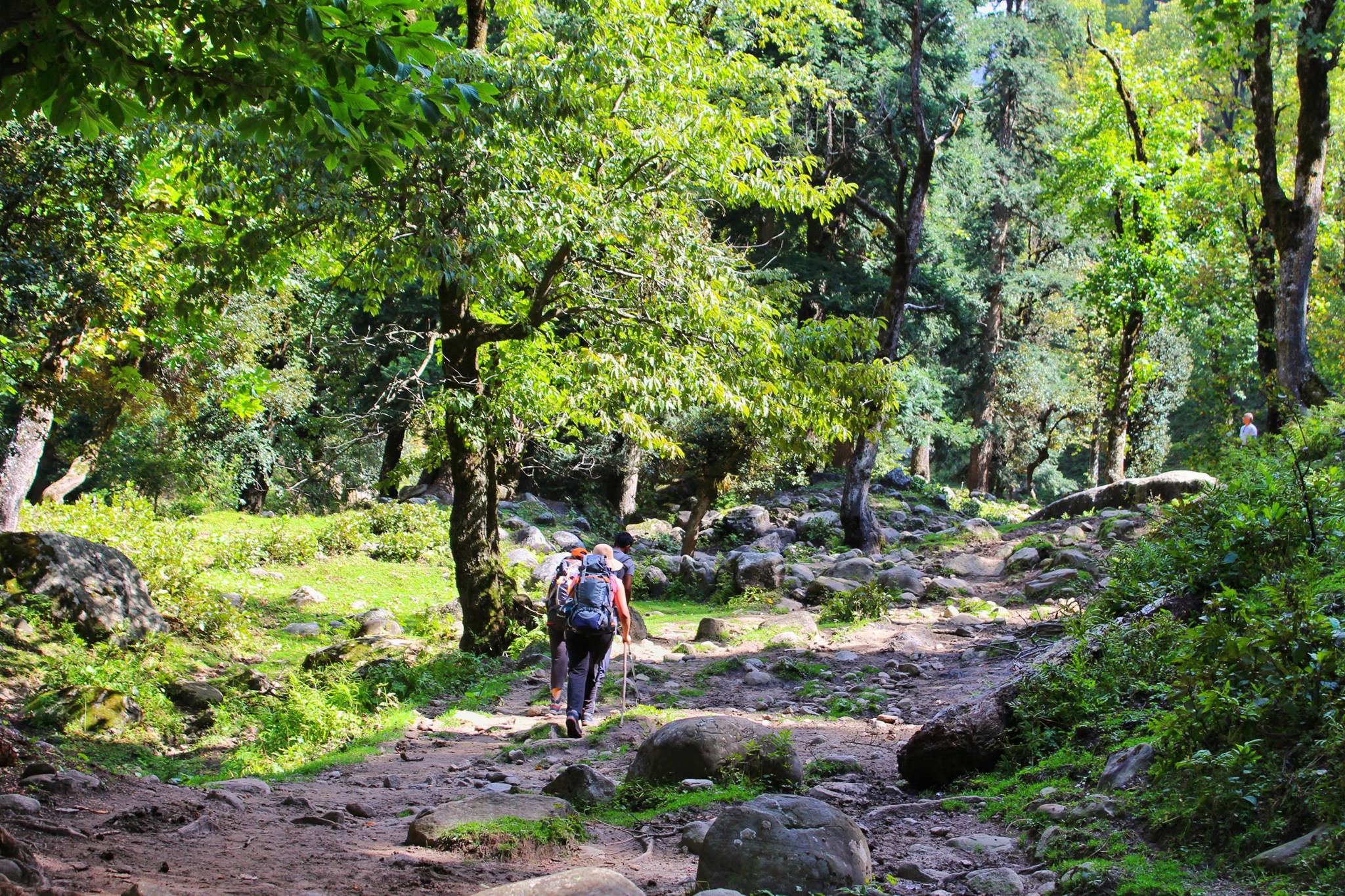
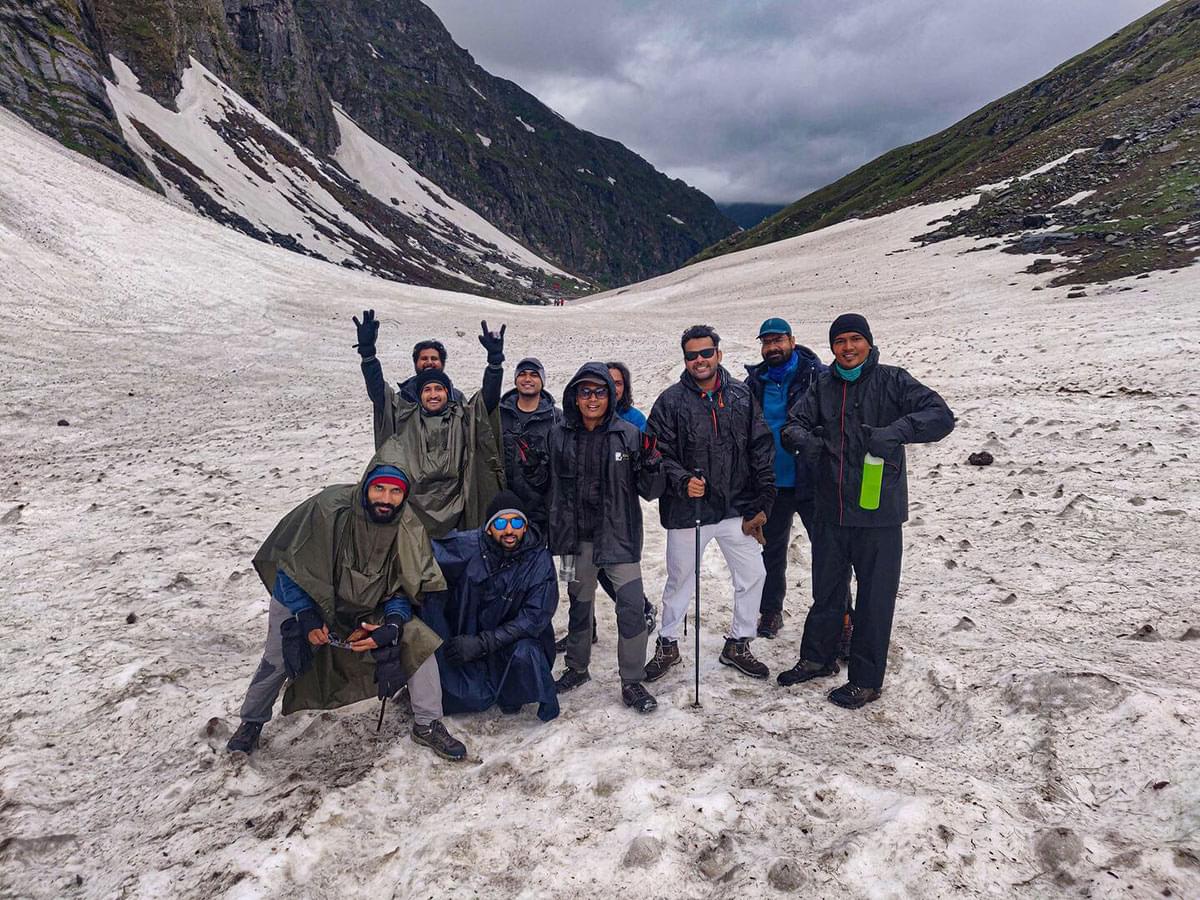
Hampta Pass Trek
Details
Inclusions
Safe Travel
Flexible Cancellation
Easy EMI
Certified Captains
24/7 Support
Overview
The Hampta Pass trek in Himachal Pradesh embodies different shades of nature to provide a contrasting landscape that consists of green canopied valleys on one side and barren earthly mountains on the other hand. A grassland with spring flowers blooming mirrored by a stark scenery consisting of jagged terrains is something that you only get to see on the Hampta Pass trek. The Hampta pass acts as a vantage point, from where you can witness two equally beautiful parts of Himachal’s topography. If you were to look in the northern direction, you’d witness the majestic Lahaul valley stretching up to a vast expanse of land, deprived of vegetation while if you were to look on the other side of the trail, you’d witness jade green forests that adorn the valley of Kullu. Although the distance that we cover in the Hampta Pass trek is merely 26 km, the entire trail with its ever-changing landscape seems like one long walk into the four seasons itself where you get to experience the warmth of golden sun rays, see spring flowers blooming in the meadows, and feel the cold that seeps through the deserts of Lahaul - Spiti.
The Hampta Pass trek trail takes you through alpine forests where Maple, Birch, Oak, and Deodar trees rustle their leaves in sync with the cool breeze. As you walk further, meadows with waving stalks of green beckon you closer, enticing you to keep walking until you reach the silver streams of water gurgling through the same paths that you are walking upon. The snowline commences after walking for a few miles where a steep ascend leads you to the Hampta pass where majestic mountains stand tall, overlooking the narrow valleys which are speckled with wildflowers. The contrast of the tenderness of the flower petals against the rugged mountains takes your breath away, as you realize that mother nature truly never fails to surprise and you get to experience this phenomenon firsthand in the dramatic shades that the Hampta Pass trek shows you. From cliffs, slanting slopes, glaciers that seem like icy carpets, rhododendron forests, and alpine lakes, every step that you take on the Hampta pass trail unravels a new side to the trekkers. In this Hampta Pass trek itinerary, the starting point is the town of Manali. We drive from Manali to Jobra which is the base for the Hampta Pass trek. The entire drive seems like a road trip straight out of the movies where you are traversing through almost 42 hairpin bends in the road and witnessing the glory of mountains with each turn of your vehicle with the picturesque Kullu valley in the backdrop. The heat of Manali dissipates to give way to a cool breeze as you drive further away from the city roads and towards Jobra with the Rani Nallah River, flowing right alongside you. Upon reaching Jobra, a brief trekking session conducted by the trek leader where all the necessary details about what the Hampta Pass trek entails, we make our way to Chika, the first campsite of our trek.
Nestled in the Pir Panjal ranges of the Himalayas, the difficulty level for the Hampta pass trek is easy to moderate level with the maximum altitude attained in five days being 14100 Ft. The trek has a few high-altitude campsites and Chika nestled at an altitude of 10,000ft is the first one of them. However since it’s approx 2 kilometers from Jobra, it doesn’t test your endurance as much. The trail has enough resources for water and is speckled with pine trees, green maple, and sparkling silver birch trees making the topography diverse and extremely rich. All along the streams of the Rani Nallah river pass through the meadow where we set up camp for the night. After having an early morning breakfast in the mountains, we start our ascent towards our next campsite Balu ka Ghera as we traverse through green pastures for the first half of our trail which is then followed by boulders and loose rocks as you move forward. All the while the stream of the Jwara river runs through the water with its silver cascading streams giving the green landscape a pearly glow. As you gradually incline towards Balu ka Ghera, the mighty Dhauladhar ranges in the backdrop peak from behind, adding all the more glory to the scenery. The stretch is almost 9 km and the meadows make it easier for trekkers to pass through without exhausting themselves but as you move towards the rugged terrains made of boulders, it starts to put a strain on you which is why the ascend from Jobra to Balu ka Ghera is considered to be of moderate category. Balu itself means sand and the trail towards this campsite lives up to its name with its coarse sand topography. On the other side of the river, wildflowers grow along with birch and rhododendrons trees on the foothills, providing a stark contrast to the bare ground where we set camp for the night. The trek from Balu ka Ghera to Sia Goru encompasses a steep uphill trail that is both challenging and rewarding at the same time. In a matter of approx six hours, you gain a considerable amount of altitude. The trek starts with slanting slopes and then as you cross a shallow lake you will stumble upon it afterward, the trail turns uphill with traces of snow stretching in front of you, and after crossing three steep ridges, you get the first glimpse of Hampta pass.
The Hampa Pass acts as a wide passageway between the Lahaul valley and the Kullu Valley making it the only trek with such a striking crossover. The pass itself looks like a narrow valley, one that blooms with flowers and is overlooked by mountains with silver streams flowing through the meadows. You’d probably expect the pass to open up as soon as you take your first step towards it but you have to walk a bit before it drops you off into the lap of the Himalayas with the Deo Tibet peak beckoning you closer. The trek from Balu ka Ghera to Hampta stretches up to a distance of almost three kilometers and is of moderate category since the pass has a gradual steep ascent and the trail only, later on, turns into a flat walk as you descend towards Sia Goru which would be our next campsite. Nestled at an altitude of 12,900 feet, Sia Goru with its Eden-like landscape, and river streams are one of the best high-altitude campsites in this Hampta pass trek itinerary. The next day as you bid goodbye to this campsite and start your descent towards Chhatru, you’d be traversing on sedimentation of rocks that transform into ridges as they keep getting carried down from the glaciers and deposit on the trail over the years.
The trail to Chhatru consists of inclines and loose rocks making this part of the trek moderate. After being so mesmerized by the green canopies that you previously witnessed, the lack of vegetation might astonish you but the beauty of the Hampta pass trek lies in its ability to keep surprising you with its ever-changing landscape. The barrenness of Chhatru would feel rewarding because once we’ve reached Chhatru, we would drive towards Chandratal which is one of the highlights of the Hampta pass trek. The crescent moon-shaped lake is one of the best places to visit in the Lahaul Spiti region and many people spend a lot of money to be able to see this pristine lake but on this Hampta pass trek, you get to experience the beauty of Chandrataal itself since the lake is located only 45 kilometers away from Chhatru and a visit to Chandratal is a must when on the Hampta Pass trek. After a visit to Chandratal lake, we will head back to Chhatru where we will spend the night before driving back to Manali the next day.
Although the Hampta pass retains its pristine beauty throughout the year, the best time to do the Hampta Pass trek is from June to September simply because the chances of witnessing patches of snow on the high passes are more in the early days of the season as it later melts down completely by the time August arrives. As the monsoon arrives, the Kullu valley gets prone to rain but on the other hand, Spiti gets summery bright days as usual.
A beautiful view of blooming flowers accompanies you through a substantial part of the trail. Their fresh smell keeps you energized throughout. A narrow green valley protected by snow-covered mountains is a bonus.
When it comes to the difficulty level, Hampta Pass Trek is moderate. The difficulty level ranges because along with the contrasting landscape, there is a stark difference in the terrain which ranges from steep uphills to almost flat grasslands. For the most part, it’s just a simple hike through the valley, but the terrain becomes difficult as you approach the pass. The pass crossing day is a long walk and may take up to 9 hours. Hampta Pass Trek is an ideal trek for fit first-timers, owing to its varied difficulty level. Hampta Pass does not pose much of a safety challenge. It is considered to be a pretty safe trek as compared to the other high-altitude treks but at the same time, although the Hampta pass trek is considered safe, one must be careful around the stream crossings and the descent from the pass down to Sia Goru campsite. The total time taken to complete this trek is usually around five days, covering a 26 Kilometers stretch of land where you gain an altitude of 14,100ft.
Gallery




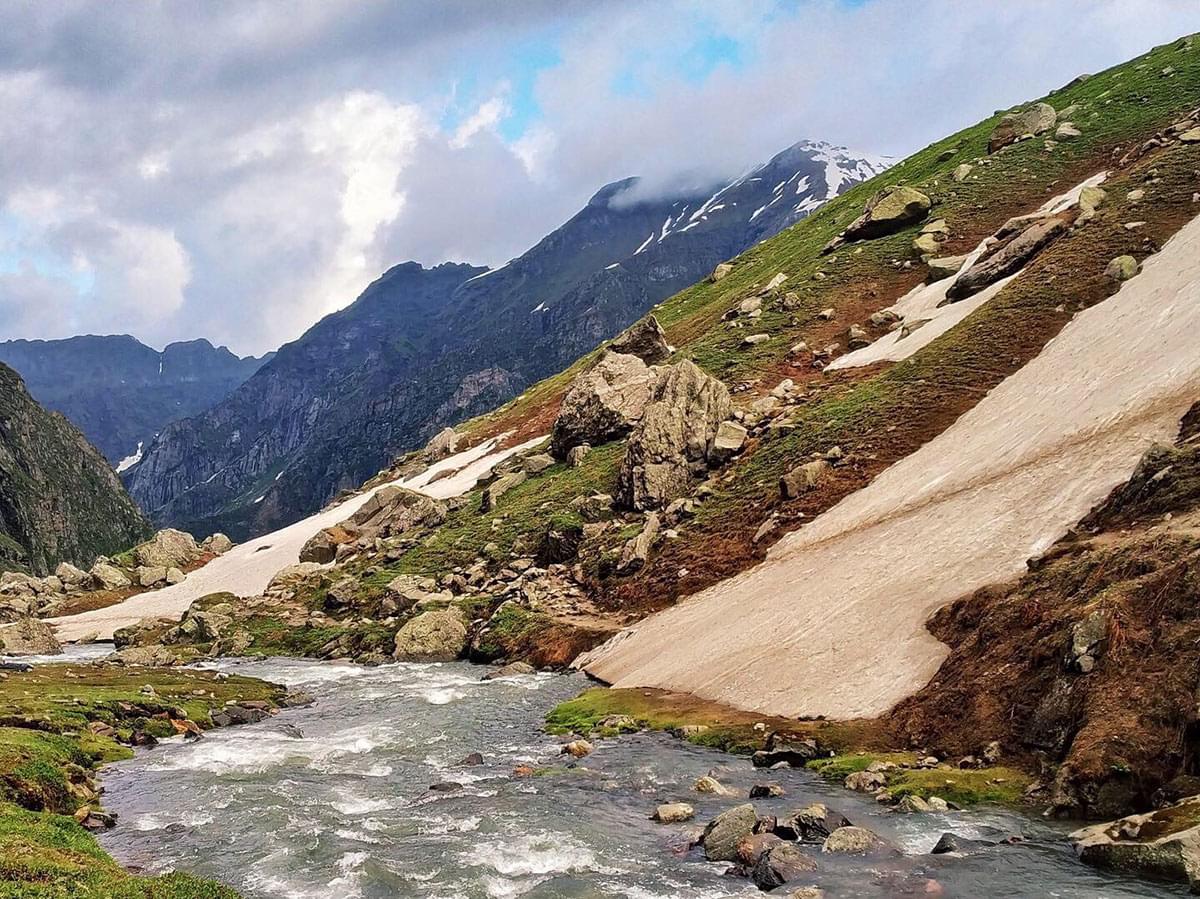
Itinerary
1
Day
Manali Arrival | Drive to Jobra (45 mins drive) | Trek to Chika (2 Kms Trek)
2
Day
Chika to Balu Ka Ghera Trek (8.5 Kms, 6 hrs)
3
Day
Balu Ka Ghera to Siagoru Trek via Hampta Pass (7 Kms, 9 hrs)
4
Day
Siagoru to Chatru Trek (7 Kms, 5 hrs) | Chatru to Chandratal Drive (48 Kms, 3 Hrs) | Back to Chatru
5
Day
Drive from Chatru to Manali (63 Kms, 2.5 Hrs) | Tour Ends
Age Limit (Trip Wise)
Weekend
Getaways
18-38
Himalayan
Treks
18-48
Backpacking
Trips
18-40
Biking
Trips
18-45
Customized
Trips
No Limit
Inclusions & Exclusions
| Inclusions | Exclusions |
Accommodation: 4 Nights of Tented Accommodation on a double / triple sharing basis as per booking. Transportation: Surface transfer from Manali to Manali by Sumo / Bolero. Meals: All Veg meals from Day 1st lunch to Day 5th breakfast. Snacks: Morning / Evening Tea / Coffee with light snacks. Camping logistics: Tent, Sleeping bags, Mattresses, Dining tent, Toilet tent. Trek Leader: Qualified and Experienced Trek leader and support staff. Permits: All necessary fees and permits. Trekking Equipment: Gaiters, Micro Spikes, and Rope if required. Safety Equipment: Basic First Aid kit with Oximeter and Oxygen Cylinder. Guide ratio: 1:10 Others : Cloak Room facility available at base camp for extra luggage. | Any expenses of personal nature. Meals during transit. Insurance of any kind. Any fees and permits (For Foreigners). Unscheduled delay due to a landslide. Cost Escalation due to “Force Majeure and Evacuation charges”. Anything not mentioned explicitly in the above program. Note: You can apply for travel insurance prior to the trek. |
Cancellation Policy
| Upto 21 days | 20-15 days | 14-8 days | 7-0 days | |
| Batch Shifting | ||||
| Cancellation Charge | Free Cancellation | 25% of the Trip Amount | 50% of the Trip Amount | 100% of the Trip Amount |
| Booking Amount | Refunded in mode of Credit Note | Adjusted in Refund Deduction | Adjusted in Refund Deduction | No Refund |
| Remaining Amount | Full Refund (minus) booking amount | Refund (minus) 25% of the trip amount | Refund (minus) 50% of the trip amount | No Refund |
Payment Policy
| Upto 21 days | 21-15 days | 14-08 days | 07-03 days | |
|---|---|---|---|---|
| Booking Amount | ||||
| 50% Payment | Optional | Compulsory | ||
| 75% Payment | Optional | Optional | Compulsory | |
| 100% Payment | Optional | Optional | Optional | Compulsory |
Things To Pack
Rucksack:
You must pick a good quality backpack with a comfortable fit and straps that won’t give you shoulder pain. You can check out your nearest Decathlon store for a good trekking backpack.
You must pick a good quality backpack with a comfortable fit and straps that won’t give you shoulder pain. You can check out your nearest Decathlon store for a good trekking backpack.
Day Bag / Day Pack:
When you head towards the summit, you are required to carry only a few necessary items and for that, you need a day backpack as you will leave your bigger one on the campsite.
When you head towards the summit, you are required to carry only a few necessary items and for that, you need a day backpack as you will leave your bigger one on the campsite.
Hiking Shoes :
Durable footwear designed for rugged terrains.
Durable footwear designed for rugged terrains.
Floaters or Sandals:
Although the entire trek requires a good quality shoe, you still need to let your feet breathe to avoid chafing and blisters. When you are at the camp, a good pair of sandals and floaters will help you to move freely.
Although the entire trek requires a good quality shoe, you still need to let your feet breathe to avoid chafing and blisters. When you are at the camp, a good pair of sandals and floaters will help you to move freely.
Tees / Tshirts:
You must keep at least three pairs of quick dry tees so that you can wash them in between stops for proper hygiene.
You must keep at least three pairs of quick dry tees so that you can wash them in between stops for proper hygiene.
Poncho:
A poncho is an evolved form of a raincoat that provides coverage to your body as well as your bag and ensures total water protection from rain.
A poncho is an evolved form of a raincoat that provides coverage to your body as well as your bag and ensures total water protection from rain.
Quick Dry Towel:
A quick dry towel will help in maintaining proper hygiene. It must dry quickly because the wet fabric will only increase the chance of bacterial growth.
A quick dry towel will help in maintaining proper hygiene. It must dry quickly because the wet fabric will only increase the chance of bacterial growth.
Sanitizer:
Essential for maintaining cleanliness while trekking.
Essential for maintaining cleanliness while trekking.
Sun Cap / Hat:
A lightweight sun cap with side flaps is perfect to keep your head cool and avoid sunburns on a sunny day.
A lightweight sun cap with side flaps is perfect to keep your head cool and avoid sunburns on a sunny day.
Sunscreen SPF 40+:
To avoid sunburns and chafing, you need to put on sunscreen as well as cold cream.
To avoid sunburns and chafing, you need to put on sunscreen as well as cold cream.
Water Bottle (Re-usable):
Hydration is extremely important when it comes to trekking. Carrying a water bottle that you can refill with Himalayan water is a must.
Hydration is extremely important when it comes to trekking. Carrying a water bottle that you can refill with Himalayan water is a must.
Personal Toiletries:
A bag with all your essentials including napkins, toothpaste, sanitizers, paper soap, etc should be carried in a ziplock bag.
A bag with all your essentials including napkins, toothpaste, sanitizers, paper soap, etc should be carried in a ziplock bag.
Personal Medication / First Aid:
A few cuts and bruises are almost inevitable when you are on a trek so carrying a medical kit with bandages, Dettol, etc is necessary.
A few cuts and bruises are almost inevitable when you are on a trek so carrying a medical kit with bandages, Dettol, etc is necessary.
Sun Glasses / Reading Glasses:
Photochromatic glasses are specs that are designed to transform into anti-glare shades depending upon exposure to the sun. They are good when it comes to eye protection but one can also opt for clip-on glasses etc.
Photochromatic glasses are specs that are designed to transform into anti-glare shades depending upon exposure to the sun. They are good when it comes to eye protection but one can also opt for clip-on glasses etc.
Charger:
To keep your electronic devices powered during the trip.
To keep your electronic devices powered during the trip.
Power Bank:
Ensures your devices stay charged when there are no outlets.
Ensures your devices stay charged when there are no outlets.
Personal Documents & ID's:
Identification proofs like Aadhar Card, Drivers License.
Identification proofs like Aadhar Card, Drivers License.
Laundry Bag (Waterproof):
In case your clothes get wet or your garments don’t dry, you can carry them in polythene. However, make sure that all the plastic that you are carrying into the woods leaves with you. Don’t litter in the mountains.
In case your clothes get wet or your garments don’t dry, you can carry them in polythene. However, make sure that all the plastic that you are carrying into the woods leaves with you. Don’t litter in the mountains.
Track Pants:
A good pair of track pants made of polyester will let your skin breathe. They’re lightweight, dry easily, and comfortable to walk around in. You can easily avoid chafing and rashes by investing in a good pair of track pants.
A good pair of track pants made of polyester will let your skin breathe. They’re lightweight, dry easily, and comfortable to walk around in. You can easily avoid chafing and rashes by investing in a good pair of track pants.
Trekking Shoes:
A good trekking shoe is comfortable, provides ankle support, and has a good grip as well. They shouldn’t be chunky, instead, they should be lightweight and sturdy.
A good trekking shoe is comfortable, provides ankle support, and has a good grip as well. They shouldn’t be chunky, instead, they should be lightweight and sturdy.
Cotton Socks:
Cotton socks are extremely comfortable to move around in and are lightweight as well which is why you can always count on a good pair of cotton socks while trekking. However, keep in mind to change them and avoid wearing them when they are wet.
Cotton socks are extremely comfortable to move around in and are lightweight as well which is why you can always count on a good pair of cotton socks while trekking. However, keep in mind to change them and avoid wearing them when they are wet.
Woolen Socks:
A good pair of woolen socks, especially merino, are comfortable, limit odors and provide adequate insulation from the cold so you can wear them at night.
A good pair of woolen socks, especially merino, are comfortable, limit odors and provide adequate insulation from the cold so you can wear them at night.
Woolen Gloves:
Insulated gloves help in maintaining proper body heat in your hands and also provide a better grasp on trekking poles.
Insulated gloves help in maintaining proper body heat in your hands and also provide a better grasp on trekking poles.
Main Jacket:
It’s emphasized that you need to carry proper layers so you can avoid getting cold which is why you need to carry a heavy jacket that you can put on over your other clothes.
It’s emphasized that you need to carry proper layers so you can avoid getting cold which is why you need to carry a heavy jacket that you can put on over your other clothes.
Woolen Cap:
A woolen cap will help prevent cold when you ascend to high altitude. You can also cover your ears to avoid any pain and discomfort you might face in them when going at high altitudes.
A woolen cap will help prevent cold when you ascend to high altitude. You can also cover your ears to avoid any pain and discomfort you might face in them when going at high altitudes.
Hoodie:
A versatile layering option for various temperatures.
A versatile layering option for various temperatures.
Scarf / Balaclava:
Along with sun rays and chilly winds, you also get hit by dirt and grime during treks which is why it's important to carry a scarf or balaclava so you can cover your face when needed.
Along with sun rays and chilly winds, you also get hit by dirt and grime during treks which is why it's important to carry a scarf or balaclava so you can cover your face when needed.
Head Lamp:
You can’t rely on moonlight when you are in the mountains. A torch or even a headlamp with a fresh pair of batteries is always a good idea to bring along.
You can’t rely on moonlight when you are in the mountains. A torch or even a headlamp with a fresh pair of batteries is always a good idea to bring along.
Trekking Pole:
The trekking pole assists in more than one way. It saves energy while also providing stability and helps you to maintain proper balance.
The trekking pole assists in more than one way. It saves energy while also providing stability and helps you to maintain proper balance.
Camera:
This should be obvious. To make sure that you get to capture all the great moments from your trek. Make sure that you have enough storage and some extra batteries as well.
This should be obvious. To make sure that you get to capture all the great moments from your trek. Make sure that you have enough storage and some extra batteries as well.
Riding Gear:
If your trip involves biking or motorcycling.
If your trip involves biking or motorcycling.
Moisturiser & Cold Cream:
To avoid sunburns and chafing, you need to put on sunscreen as well as cold cream.
To avoid sunburns and chafing, you need to put on sunscreen as well as cold cream.
Lip Balm:
Your lips can become chapped due to the harsh cold winds so it's important to keep them moisturized.
Your lips can become chapped due to the harsh cold winds so it's important to keep them moisturized.
Sanitary Pads:
Essential for feminine hygiene.
Essential for feminine hygiene.
Insect Repellent:
Guards against pesky bugs and insects.
Guards against pesky bugs and insects.
Cash:
Emergency funds for unexpected situations.
Emergency funds for unexpected situations.
Thermals:
Thermal is a piece of garment that helps in keeping your body warm in cold temperatures. It is a necessary item that you need when going on a high-altitude trek.
Thermal is a piece of garment that helps in keeping your body warm in cold temperatures. It is a necessary item that you need when going on a high-altitude trek.
Snacks / Dryfruits / Energy Bar:
Provides quick energy on the go.
Provides quick energy on the go.
Positive Attitude:
The most important item for a successful trek or trip, keeping your spirits high and adaptable to the challenges of the journey.
The most important item for a successful trek or trip, keeping your spirits high and adaptable to the challenges of the journey.
Everything you need to know about Hampta Pass
The Hampta Pass trek is a beautiful journey through the Himalayas in Himachal Pradesh, India. This trek is perfect for those who love nature and adventure. The best time to go on this trek is from June to September when the weather is pleasant and the valleys are lush and green. The Hampta Pass trek is considered a moderate-level trek, with a gradual climb to the pass and a steep descent on the other side. The trek takes you through dense forests, meandering rivers, and lush pastures. As you trek, you'll be treated to panoramic views of the surrounding mountains, including the majestic Indrasan and Deo Tibba peaks. The trail starts in the Kullu Valley and takes you through the charming village of Prini, where you'll find traditional Himachali houses and friendly locals. The trail then takes you through the beautiful Jobra and Jwara meadows, where you'll see a variety of wildflowers in bloom.
The highlight of the trek is the Hampta Pass, which sits at an altitude of 14,039 feet (4,279 meters). From here, you'll have breathtaking views of the Lahaul and Spiti Valleys. The descent from the pass is steep, but the stunning views of the surrounding mountains make it worth the effort. The last point of the trek is the beautiful Chandratal Lake in the Lahaul and Spiti Valley. This lake is known for its crystal-clear waters and stunning sunsets. The trek is particularly popular among tourists from Delhi and Chandigarh, who come to escape the heat of the city and experience the cool mountain air. To go on the Hampta Pass trek, you need to be physically fit and well-prepared. The trek is not recommended for beginners, as it requires a certain level of fitness and experience. However, with the right preparation and guidance, the Hampta Pass trek is a once-in-a-lifetime experience that you'll never forget. Hampta Pass trek is a beautiful journey through the Himalayas that offers stunning views of snow-capped peaks, lush valleys, and crystal-clear lakes. If you're looking for a challenging and rewarding adventure, the Hampta Pass trek is the perfect choice. Just make sure you're physically fit and well-prepared, and you'll have the experience of a lifetime.
By Flight: The nearest airport to reach Hampta Pass Trek is Kullu-Manali Airport in Bhuntar, which is approximately 50 kilometers away from Manali. From the airport, you can take a cab or a bus to reach Manali, and from there, you can hire a private or shared taxi to reach the base camp of the Hampta Pass Trek at Jobra.
By Train: The nearest railway station to reach Hampta Pass Trek is Joginder Nagar Railway Station, which is approximately 145 kilometers away from Manali. From the railway station, you can take a cab or a bus to reach Manali, and from there, you can hire a private or shared taxi to reach the base camp of the Hampta Pass Trek at Jobra.
By Bus: Manali is well-connected by road to major cities in North India, and you can take a bus from Delhi, Chandigarh, or Shimla to reach Manali. From Manali, you can hire a private or shared taxi to reach the base camp of the Hampta Pass Trek at Jobra. The distance between Manali and Jobra is approximately 28 kilometers, and it takes around 1-2 hours to reach Jobra by road.
Best time to Visit Hampta Pass
The best time to visit Hampta Pass is during the summer months, specifically from June to October, when the weather conditions are ideal for trekking. During this period, the temperature ranges from 10 to 20 degrees Celsius in the daytime, making the trekking experience enjoyable. The skies are often clear, offering breathtaking views of the surrounding Himalayan peaks. In June, the snow starts to melt, revealing lush green meadows and vibrant wildflowers. The landscape continues to transform through the seasons, offering a riot of colors in autumn and a serene white blanket in early winter. The wildlife in the region is also most active during these months, providing opportunities for wildlife sightings.
Highlights of Hampta Pass
The Hampta Pass Trek offers a plethora of unique experiences and breathtaking sights. Here are some of the standout highlights that set this trek apart:
- Commencing from the picturesque hill station of Manali, visitors are enchanted by its apple orchards, tranquil rivers, and lush meadows. Manali is not just a starting point but a destination in itself, worthy of exploration before embarking on the trek.
- A notable feature of the Hampta Pass Trek is the remarkable transition in landscapes. As you journey on, the scenery evolves from the lush Kullu Valley to the rugged, barren terrain of the Lahaul Valley and Spiti, captivating trekkers throughout.
- Traversing sparkling rivers and glaciers adds an unforgettable dimension to the trek, making the adventure even more thrilling.
- Ascending to an elevation of 14,000 feet, crossing the Hampta Pass is a significant achievement. The breathtaking panoramic views of the surrounding peaks are truly awe-inspiring, making this a standout moment of the trek.
- Included in the itinerary is a visit to the enchanting Chandratal Lake, with its crystal-clear, azure waters. This high-altitude lake's ethereal beauty serves as a perfect conclusion to the exhilarating trek.
VIDEOS
Memories for Life
posts
Instagram Images
REVIEWS
What our Clients Say About Us
blogs
Our Blogs
Faq
Have any Doubts
What will be the type of accommodation for the Hampta Pass Trek?
There would be tented accommodations throughout the trek on a sharing basis.
Are mobile networks available on the Hampta Pass Trek?
You'll only get mobile networks for Airtel, Jio and others at Jobra which is the basecamp for the Hampta Pass Trek. There would be no connectivity on the trek or on the summit.
Is Hampta Pass open in February?
Hampta Pass remains inaccessible in February due to heavy snowfall. Since the trail is steep at points, snowfall increases the risk of falling and getting injured even more so than usual.
Which shoes should I buy for the Hampta Pass Trek?
Good quality shoes are always recommended for trekking. You need to be careful about your purchase and make sure that the soles have a good grip and that the shoes are water repellent/waterproof with high ankle length. We recommend you to check out Decathlon.
What Is the height of Hampta Pass?
Hampta Pass is nestled at an altitude of 14,100ft in the Pir Panjal range of the Himalayas.
How many days is the Hampta Pass Trek?
The Hampta Pass Trek can be done in 5 days but an additional day is required to visit the pristine Chandratal. Without Chandratal, the trek feels incomplete.
How do I prepare for the Hampta Pass Trek?
Hampta Pass Trek is considered to be a moderate trek that gradually becomes difficult as you move towards the Pass. There are a few basic fitness tips that you can follow when preparing for the Hampta Pass Trek.
1) Run for 30 - 45 mins atleast twice a week.
2) Stair climbing. Skip the elevators and take stairs instead.
3) Keep your body active by doing regular exercises. Jogging, Skipping and other cardiovascular activities help build endurance which would help you when you're trekking.
4) Train with your backpack before your trek.
Will there be Snow in Hampta Pass Trek in June?
Yes! If you're visiting Hampta Pass in June then you'll surely experience snow there although it won't be as thick as it is during winters.
Can we do the Hampta Pass Trek alone?
Trekking solo in the Himalayas always comes with a lot risks. It is not advisable for novice trekkers to do any trek solo let alone the Hampta Pass Trek. Experienced trekkers who have done high-altitude treks and have the necessary trekking gear may undertake a solo trek to Hampta Pass but it is not advisable.
Is Hampta Pass a difficult trek?
When it comes to the difficulty level, the Hampta Pass falls under the moderate category. Trekking through the valley is fairly easy but the terrain becomes tricky as you move closer to the Pass. It takes 9 hours of continuous walking for a trekker to cross the Pass. The Hampta Pass can be considered a beginner-friendly trek when done under proper guidance.
How to reach Hampta Pass From Mumbai?
You need to take a flight from Mumbai to Chandigarh and then you need to head to Manali via road. You can take a bus. From Manali, you'll reach Jobra, which is the starting of the Hampta Pass Trek.
How far is Hampta Pass from Manali?
The distance between Hampta Pass and Manali is approximately 30 Kilometers.
Which month is best for the Hampta Pass Trek?
The best time to do the Hampta Pass Trek is from June to October. You'd get to witness snowfall early on but by the time August arrives, the snow melts away completely and the valley blooms with flowers, and lush greenery takes over the landscape.
What is the length of the Hampta Pass Trek?
The stretch of the Hampta Pass trekking trail is approximately 26 Kilometers.
Where is Hampta Pass located?
Nestled in the Pir Panjal ranges of the Himalayas, Hampta Pass is a high-altitude mountain pass that connects the Chandra Valley in Lahaul to the Kullu Valley in Himachal. It is located in the Kullu district of Himachal Pradesh and takes you to Lahaul in 5 days.
How to reach the basecamp for the Hampta Pass Trek?
Jobra is the basecamp for the Hampta Pass Trek. It's 30 kilometers from Manali and it takes about 45 mins to reach there.
TRIPS
Related Trips





Hampta Pass Trek
Details
Inclusions
Safe Travel
Flexible Cancellation
Easy EMI
Certified Captains
24/7 Support
Overview
The Hampta Pass trek in Himachal Pradesh embodies different shades of nature to provide a contrasting landscape that consists of green canopied valleys on one side and barren earthly mountains on the other hand. A grassland with spring flowers blooming mirrored by a stark scenery consisting of jagged terrains is something that you only get to see on the Hampta Pass trek. The Hampta pass acts as a vantage point, from where you can witness two equally beautiful parts of Himachal’s topography. If you were to look in the northern direction, you’d witness the majestic Lahaul valley stretching up to a vast expanse of land, deprived of vegetation while if you were to look on the other side of the trail, you’d witness jade green forests that adorn the valley of Kullu. Although the distance that we cover in the Hampta Pass trek is merely 26 km, the entire trail with its ever-changing landscape seems like one long walk into the four seasons itself where you get to experience the warmth of golden sun rays, see spring flowers blooming in the meadows, and feel the cold that seeps through the deserts of Lahaul - Spiti.
The Hampta Pass trek trail takes you through alpine forests where Maple, Birch, Oak, and Deodar trees rustle their leaves in sync with the cool breeze. As you walk further, meadows with waving stalks of green beckon you closer, enticing you to keep walking until you reach the silver streams of water gurgling through the same paths that you are walking upon. The snowline commences after walking for a few miles where a steep ascend leads you to the Hampta pass where majestic mountains stand tall, overlooking the narrow valleys which are speckled with wildflowers. The contrast of the tenderness of the flower petals against the rugged mountains takes your breath away, as you realize that mother nature truly never fails to surprise and you get to experience this phenomenon firsthand in the dramatic shades that the Hampta Pass trek shows you. From cliffs, slanting slopes, glaciers that seem like icy carpets, rhododendron forests, and alpine lakes, every step that you take on the Hampta pass trail unravels a new side to the trekkers. In this Hampta Pass trek itinerary, the starting point is the town of Manali. We drive from Manali to Jobra which is the base for the Hampta Pass trek. The entire drive seems like a road trip straight out of the movies where you are traversing through almost 42 hairpin bends in the road and witnessing the glory of mountains with each turn of your vehicle with the picturesque Kullu valley in the backdrop. The heat of Manali dissipates to give way to a cool breeze as you drive further away from the city roads and towards Jobra with the Rani Nallah River, flowing right alongside you. Upon reaching Jobra, a brief trekking session conducted by the trek leader where all the necessary details about what the Hampta Pass trek entails, we make our way to Chika, the first campsite of our trek.
Nestled in the Pir Panjal ranges of the Himalayas, the difficulty level for the Hampta pass trek is easy to moderate level with the maximum altitude attained in five days being 14100 Ft. The trek has a few high-altitude campsites and Chika nestled at an altitude of 10,000ft is the first one of them. However since it’s approx 2 kilometers from Jobra, it doesn’t test your endurance as much. The trail has enough resources for water and is speckled with pine trees, green maple, and sparkling silver birch trees making the topography diverse and extremely rich. All along the streams of the Rani Nallah river pass through the meadow where we set up camp for the night. After having an early morning breakfast in the mountains, we start our ascent towards our next campsite Balu ka Ghera as we traverse through green pastures for the first half of our trail which is then followed by boulders and loose rocks as you move forward. All the while the stream of the Jwara river runs through the water with its silver cascading streams giving the green landscape a pearly glow. As you gradually incline towards Balu ka Ghera, the mighty Dhauladhar ranges in the backdrop peak from behind, adding all the more glory to the scenery. The stretch is almost 9 km and the meadows make it easier for trekkers to pass through without exhausting themselves but as you move towards the rugged terrains made of boulders, it starts to put a strain on you which is why the ascend from Jobra to Balu ka Ghera is considered to be of moderate category. Balu itself means sand and the trail towards this campsite lives up to its name with its coarse sand topography. On the other side of the river, wildflowers grow along with birch and rhododendrons trees on the foothills, providing a stark contrast to the bare ground where we set camp for the night. The trek from Balu ka Ghera to Sia Goru encompasses a steep uphill trail that is both challenging and rewarding at the same time. In a matter of approx six hours, you gain a considerable amount of altitude. The trek starts with slanting slopes and then as you cross a shallow lake you will stumble upon it afterward, the trail turns uphill with traces of snow stretching in front of you, and after crossing three steep ridges, you get the first glimpse of Hampta pass.
The Hampa Pass acts as a wide passageway between the Lahaul valley and the Kullu Valley making it the only trek with such a striking crossover. The pass itself looks like a narrow valley, one that blooms with flowers and is overlooked by mountains with silver streams flowing through the meadows. You’d probably expect the pass to open up as soon as you take your first step towards it but you have to walk a bit before it drops you off into the lap of the Himalayas with the Deo Tibet peak beckoning you closer. The trek from Balu ka Ghera to Hampta stretches up to a distance of almost three kilometers and is of moderate category since the pass has a gradual steep ascent and the trail only, later on, turns into a flat walk as you descend towards Sia Goru which would be our next campsite. Nestled at an altitude of 12,900 feet, Sia Goru with its Eden-like landscape, and river streams are one of the best high-altitude campsites in this Hampta pass trek itinerary. The next day as you bid goodbye to this campsite and start your descent towards Chhatru, you’d be traversing on sedimentation of rocks that transform into ridges as they keep getting carried down from the glaciers and deposit on the trail over the years.
The trail to Chhatru consists of inclines and loose rocks making this part of the trek moderate. After being so mesmerized by the green canopies that you previously witnessed, the lack of vegetation might astonish you but the beauty of the Hampta pass trek lies in its ability to keep surprising you with its ever-changing landscape. The barrenness of Chhatru would feel rewarding because once we’ve reached Chhatru, we would drive towards Chandratal which is one of the highlights of the Hampta pass trek. The crescent moon-shaped lake is one of the best places to visit in the Lahaul Spiti region and many people spend a lot of money to be able to see this pristine lake but on this Hampta pass trek, you get to experience the beauty of Chandrataal itself since the lake is located only 45 kilometers away from Chhatru and a visit to Chandratal is a must when on the Hampta Pass trek. After a visit to Chandratal lake, we will head back to Chhatru where we will spend the night before driving back to Manali the next day.
Although the Hampta pass retains its pristine beauty throughout the year, the best time to do the Hampta Pass trek is from June to September simply because the chances of witnessing patches of snow on the high passes are more in the early days of the season as it later melts down completely by the time August arrives. As the monsoon arrives, the Kullu valley gets prone to rain but on the other hand, Spiti gets summery bright days as usual.
A beautiful view of blooming flowers accompanies you through a substantial part of the trail. Their fresh smell keeps you energized throughout. A narrow green valley protected by snow-covered mountains is a bonus.
When it comes to the difficulty level, Hampta Pass Trek is moderate. The difficulty level ranges because along with the contrasting landscape, there is a stark difference in the terrain which ranges from steep uphills to almost flat grasslands. For the most part, it’s just a simple hike through the valley, but the terrain becomes difficult as you approach the pass. The pass crossing day is a long walk and may take up to 9 hours. Hampta Pass Trek is an ideal trek for fit first-timers, owing to its varied difficulty level. Hampta Pass does not pose much of a safety challenge. It is considered to be a pretty safe trek as compared to the other high-altitude treks but at the same time, although the Hampta pass trek is considered safe, one must be careful around the stream crossings and the descent from the pass down to Sia Goru campsite. The total time taken to complete this trek is usually around five days, covering a 26 Kilometers stretch of land where you gain an altitude of 14,100ft.
Itinerary
1
Day
Manali Arrival | Drive to Jobra (45 mins drive) | Trek to Chika (2 Kms Trek)
2
Day
Chika to Balu Ka Ghera Trek (8.5 Kms, 6 hrs)
3
Day
Balu Ka Ghera to Siagoru Trek via Hampta Pass (7 Kms, 9 hrs)
4
Day
Siagoru to Chatru Trek (7 Kms, 5 hrs) | Chatru to Chandratal Drive (48 Kms, 3 Hrs) | Back to Chatru
5
Day
Drive from Chatru to Manali (63 Kms, 2.5 Hrs) | Tour Ends
Age Limit (Trip Wise)
Weekend
Getaways
18-38
Himalayan
Treks
18-48
Backpacking
Trips
18-40
Biking
Trips
18-45
Customized
Trips
No Limit
Pricing
Select Occupancy
+5% GST *
Batches
Accommodation: 4 Nights of Tented Accommodation on a double / triple sharing basis as per booking. Transportation: Surface transfer from Manali to Manali by Sumo / Bolero. Meals: All Veg meals from Day 1st lunch to Day 5th breakfast. Snacks: Morning / Evening Tea / Coffee with light snacks. Camping logistics: Tent, Sleeping bags, Mattresses, Dining tent, Toilet tent. Trek Leader: Qualified and Experienced Trek leader and support staff. Permits: All necessary fees and permits. Trekking Equipment: Gaiters, Micro Spikes, and Rope if required. Safety Equipment: Basic First Aid kit with Oximeter and Oxygen Cylinder. Guide ratio: 1:10 Others : Cloak Room facility available at base camp for extra luggage. |
Cancellation Policy
Credit Note :
The Booking Amount will be credited to your JW Profile which can be accessed by logging in to the website through your Email ID. Credit Notes issued have no date of expiry and can be used entirely in any of your future trips.
GST :
The Booking Amount will be credited to your JW Profile which can be accessed by logging in to the website through your Email ID. Credit Notes issued have no date of expiry and can be used entirely in any of your future trips.
Payment Policy
Things To Pack
Rucksack:
You must pick a good quality backpack with a comfortable fit and straps that won’t give you shoulder pain. You can check out your nearest Decathlon store for a good trekking backpack.
You must pick a good quality backpack with a comfortable fit and straps that won’t give you shoulder pain. You can check out your nearest Decathlon store for a good trekking backpack.
Day Bag / Day Pack:
When you head towards the summit, you are required to carry only a few necessary items and for that, you need a day backpack as you will leave your bigger one on the campsite.
When you head towards the summit, you are required to carry only a few necessary items and for that, you need a day backpack as you will leave your bigger one on the campsite.
Hiking Shoes :
Durable footwear designed for rugged terrains.
Durable footwear designed for rugged terrains.
Floaters or Sandals:
Although the entire trek requires a good quality shoe, you still need to let your feet breathe to avoid chafing and blisters. When you are at the camp, a good pair of sandals and floaters will help you to move freely.
Although the entire trek requires a good quality shoe, you still need to let your feet breathe to avoid chafing and blisters. When you are at the camp, a good pair of sandals and floaters will help you to move freely.
Tees / Tshirts:
You must keep at least three pairs of quick dry tees so that you can wash them in between stops for proper hygiene.
You must keep at least three pairs of quick dry tees so that you can wash them in between stops for proper hygiene.
Poncho:
A poncho is an evolved form of a raincoat that provides coverage to your body as well as your bag and ensures total water protection from rain.
A poncho is an evolved form of a raincoat that provides coverage to your body as well as your bag and ensures total water protection from rain.
Quick Dry Towel:
A quick dry towel will help in maintaining proper hygiene. It must dry quickly because the wet fabric will only increase the chance of bacterial growth.
A quick dry towel will help in maintaining proper hygiene. It must dry quickly because the wet fabric will only increase the chance of bacterial growth.
Sanitizer:
Essential for maintaining cleanliness while trekking.
Essential for maintaining cleanliness while trekking.
Sun Cap / Hat:
A lightweight sun cap with side flaps is perfect to keep your head cool and avoid sunburns on a sunny day.
A lightweight sun cap with side flaps is perfect to keep your head cool and avoid sunburns on a sunny day.
Sunscreen SPF 40+:
To avoid sunburns and chafing, you need to put on sunscreen as well as cold cream.
To avoid sunburns and chafing, you need to put on sunscreen as well as cold cream.
Water Bottle (Re-usable):
Hydration is extremely important when it comes to trekking. Carrying a water bottle that you can refill with Himalayan water is a must.
Hydration is extremely important when it comes to trekking. Carrying a water bottle that you can refill with Himalayan water is a must.
Personal Toiletries:
A bag with all your essentials including napkins, toothpaste, sanitizers, paper soap, etc should be carried in a ziplock bag.
A bag with all your essentials including napkins, toothpaste, sanitizers, paper soap, etc should be carried in a ziplock bag.
Personal Medication / First Aid:
A few cuts and bruises are almost inevitable when you are on a trek so carrying a medical kit with bandages, Dettol, etc is necessary.
A few cuts and bruises are almost inevitable when you are on a trek so carrying a medical kit with bandages, Dettol, etc is necessary.
Sun Glasses / Reading Glasses:
Photochromatic glasses are specs that are designed to transform into anti-glare shades depending upon exposure to the sun. They are good when it comes to eye protection but one can also opt for clip-on glasses etc.
Photochromatic glasses are specs that are designed to transform into anti-glare shades depending upon exposure to the sun. They are good when it comes to eye protection but one can also opt for clip-on glasses etc.
Charger:
To keep your electronic devices powered during the trip.
To keep your electronic devices powered during the trip.
Power Bank:
Ensures your devices stay charged when there are no outlets.
Ensures your devices stay charged when there are no outlets.
Personal Documents & ID's:
Identification proofs like Aadhar Card, Drivers License.
Identification proofs like Aadhar Card, Drivers License.
Laundry Bag (Waterproof):
In case your clothes get wet or your garments don’t dry, you can carry them in polythene. However, make sure that all the plastic that you are carrying into the woods leaves with you. Don’t litter in the mountains.
In case your clothes get wet or your garments don’t dry, you can carry them in polythene. However, make sure that all the plastic that you are carrying into the woods leaves with you. Don’t litter in the mountains.
Track Pants:
A good pair of track pants made of polyester will let your skin breathe. They’re lightweight, dry easily, and comfortable to walk around in. You can easily avoid chafing and rashes by investing in a good pair of track pants.
A good pair of track pants made of polyester will let your skin breathe. They’re lightweight, dry easily, and comfortable to walk around in. You can easily avoid chafing and rashes by investing in a good pair of track pants.
Trekking Shoes:
A good trekking shoe is comfortable, provides ankle support, and has a good grip as well. They shouldn’t be chunky, instead, they should be lightweight and sturdy.
A good trekking shoe is comfortable, provides ankle support, and has a good grip as well. They shouldn’t be chunky, instead, they should be lightweight and sturdy.
Cotton Socks:
Cotton socks are extremely comfortable to move around in and are lightweight as well which is why you can always count on a good pair of cotton socks while trekking. However, keep in mind to change them and avoid wearing them when they are wet.
Cotton socks are extremely comfortable to move around in and are lightweight as well which is why you can always count on a good pair of cotton socks while trekking. However, keep in mind to change them and avoid wearing them when they are wet.
Woolen Socks:
A good pair of woolen socks, especially merino, are comfortable, limit odors and provide adequate insulation from the cold so you can wear them at night.
A good pair of woolen socks, especially merino, are comfortable, limit odors and provide adequate insulation from the cold so you can wear them at night.
Woolen Gloves:
Insulated gloves help in maintaining proper body heat in your hands and also provide a better grasp on trekking poles.
Insulated gloves help in maintaining proper body heat in your hands and also provide a better grasp on trekking poles.
Main Jacket:
It’s emphasized that you need to carry proper layers so you can avoid getting cold which is why you need to carry a heavy jacket that you can put on over your other clothes.
It’s emphasized that you need to carry proper layers so you can avoid getting cold which is why you need to carry a heavy jacket that you can put on over your other clothes.
Woolen Cap:
A woolen cap will help prevent cold when you ascend to high altitude. You can also cover your ears to avoid any pain and discomfort you might face in them when going at high altitudes.
A woolen cap will help prevent cold when you ascend to high altitude. You can also cover your ears to avoid any pain and discomfort you might face in them when going at high altitudes.
Hoodie:
A versatile layering option for various temperatures.
A versatile layering option for various temperatures.
Scarf / Balaclava:
Along with sun rays and chilly winds, you also get hit by dirt and grime during treks which is why it's important to carry a scarf or balaclava so you can cover your face when needed.
Along with sun rays and chilly winds, you also get hit by dirt and grime during treks which is why it's important to carry a scarf or balaclava so you can cover your face when needed.
Head Lamp:
You can’t rely on moonlight when you are in the mountains. A torch or even a headlamp with a fresh pair of batteries is always a good idea to bring along.
You can’t rely on moonlight when you are in the mountains. A torch or even a headlamp with a fresh pair of batteries is always a good idea to bring along.
Trekking Pole:
The trekking pole assists in more than one way. It saves energy while also providing stability and helps you to maintain proper balance.
The trekking pole assists in more than one way. It saves energy while also providing stability and helps you to maintain proper balance.
Camera:
This should be obvious. To make sure that you get to capture all the great moments from your trek. Make sure that you have enough storage and some extra batteries as well.
This should be obvious. To make sure that you get to capture all the great moments from your trek. Make sure that you have enough storage and some extra batteries as well.
Riding Gear:
If your trip involves biking or motorcycling.
If your trip involves biking or motorcycling.
Moisturiser & Cold Cream:
To avoid sunburns and chafing, you need to put on sunscreen as well as cold cream.
To avoid sunburns and chafing, you need to put on sunscreen as well as cold cream.
Lip Balm:
Your lips can become chapped due to the harsh cold winds so it's important to keep them moisturized.
Your lips can become chapped due to the harsh cold winds so it's important to keep them moisturized.
Sanitary Pads:
Essential for feminine hygiene.
Essential for feminine hygiene.
Insect Repellent:
Guards against pesky bugs and insects.
Guards against pesky bugs and insects.
Cash:
Emergency funds for unexpected situations.
Emergency funds for unexpected situations.
Thermals:
Thermal is a piece of garment that helps in keeping your body warm in cold temperatures. It is a necessary item that you need when going on a high-altitude trek.
Thermal is a piece of garment that helps in keeping your body warm in cold temperatures. It is a necessary item that you need when going on a high-altitude trek.
Snacks / Dryfruits / Energy Bar:
Provides quick energy on the go.
Provides quick energy on the go.
Positive Attitude:
The most important item for a successful trek or trip, keeping your spirits high and adaptable to the challenges of the journey.
The most important item for a successful trek or trip, keeping your spirits high and adaptable to the challenges of the journey.
Everything you need to know about Hampta Pass
The Hampta Pass trek is a beautiful journey through the Himalayas in Himachal Pradesh, India. This trek is perfect for those who love nature and adventure. The best time to go on this trek is from June to September when the weather is pleasant and the valleys are lush and green. The Hampta Pass trek is considered a moderate-level trek, with a gradual climb to the pass and a steep descent on the other side. The trek takes you through dense forests, meandering rivers, and lush pastures. As you trek, you'll be treated to panoramic views of the surrounding mountains, including the majestic Indrasan and Deo Tibba peaks. The trail starts in the Kullu Valley and takes you through the charming village of Prini, where you'll find traditional Himachali houses and friendly locals. The trail then takes you through the beautiful Jobra and Jwara meadows, where you'll see a variety of wildflowers in bloom.
The highlight of the trek is the Hampta Pass, which sits at an altitude of 14,039 feet (4,279 meters). From here, you'll have breathtaking views of the Lahaul and Spiti Valleys. The descent from the pass is steep, but the stunning views of the surrounding mountains make it worth the effort. The last point of the trek is the beautiful Chandratal Lake in the Lahaul and Spiti Valley. This lake is known for its crystal-clear waters and stunning sunsets. The trek is particularly popular among tourists from Delhi and Chandigarh, who come to escape the heat of the city and experience the cool mountain air. To go on the Hampta Pass trek, you need to be physically fit and well-prepared. The trek is not recommended for beginners, as it requires a certain level of fitness and experience. However, with the right preparation and guidance, the Hampta Pass trek is a once-in-a-lifetime experience that you'll never forget. Hampta Pass trek is a beautiful journey through the Himalayas that offers stunning views of snow-capped peaks, lush valleys, and crystal-clear lakes. If you're looking for a challenging and rewarding adventure, the Hampta Pass trek is the perfect choice. Just make sure you're physically fit and well-prepared, and you'll have the experience of a lifetime.
By Flight: The nearest airport to reach Hampta Pass Trek is Kullu-Manali Airport in Bhuntar, which is approximately 50 kilometers away from Manali. From the airport, you can take a cab or a bus to reach Manali, and from there, you can hire a private or shared taxi to reach the base camp of the Hampta Pass Trek at Jobra.
By Train: The nearest railway station to reach Hampta Pass Trek is Joginder Nagar Railway Station, which is approximately 145 kilometers away from Manali. From the railway station, you can take a cab or a bus to reach Manali, and from there, you can hire a private or shared taxi to reach the base camp of the Hampta Pass Trek at Jobra.
By Bus: Manali is well-connected by road to major cities in North India, and you can take a bus from Delhi, Chandigarh, or Shimla to reach Manali. From Manali, you can hire a private or shared taxi to reach the base camp of the Hampta Pass Trek at Jobra. The distance between Manali and Jobra is approximately 28 kilometers, and it takes around 1-2 hours to reach Jobra by road.
Best time to Visit Hampta Pass
The best time to visit Hampta Pass is during the summer months, specifically from June to October, when the weather conditions are ideal for trekking. During this period, the temperature ranges from 10 to 20 degrees Celsius in the daytime, making the trekking experience enjoyable. The skies are often clear, offering breathtaking views of the surrounding Himalayan peaks. In June, the snow starts to melt, revealing lush green meadows and vibrant wildflowers. The landscape continues to transform through the seasons, offering a riot of colors in autumn and a serene white blanket in early winter. The wildlife in the region is also most active during these months, providing opportunities for wildlife sightings.
Highlights of Hampta Pass
The Hampta Pass Trek offers a plethora of unique experiences and breathtaking sights. Here are some of the standout highlights that set this trek apart:
- Commencing from the picturesque hill station of Manali, visitors are enchanted by its apple orchards, tranquil rivers, and lush meadows. Manali is not just a starting point but a destination in itself, worthy of exploration before embarking on the trek.
- A notable feature of the Hampta Pass Trek is the remarkable transition in landscapes. As you journey on, the scenery evolves from the lush Kullu Valley to the rugged, barren terrain of the Lahaul Valley and Spiti, captivating trekkers throughout.
- Traversing sparkling rivers and glaciers adds an unforgettable dimension to the trek, making the adventure even more thrilling.
- Ascending to an elevation of 14,000 feet, crossing the Hampta Pass is a significant achievement. The breathtaking panoramic views of the surrounding peaks are truly awe-inspiring, making this a standout moment of the trek.
- Included in the itinerary is a visit to the enchanting Chandratal Lake, with its crystal-clear, azure waters. This high-altitude lake's ethereal beauty serves as a perfect conclusion to the exhilarating trek.
Similar Packages
posts
Instagram Images
REVIEWS
What our Clients Say About Us
blogs
Our Blogs
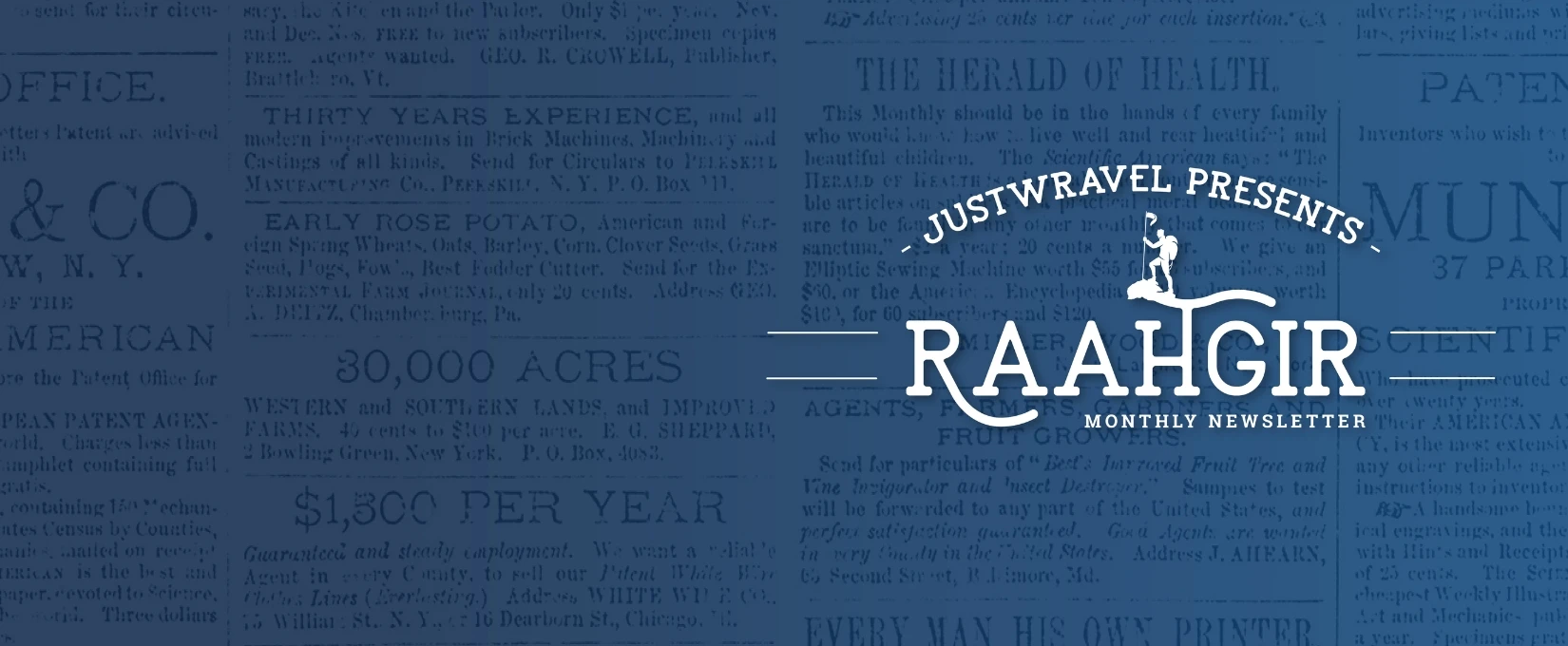
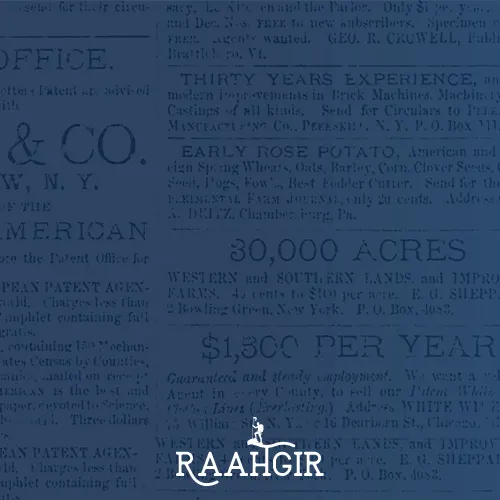
Newsletter
Sign up now!
Be the first one to know all about the Exciting Offers, Travel Updates and more.

B-42, 2nd Floor, Tower- B, The Corenthum, Block A, Sector 62, Noida, Uttar Pradesh 201301
© 2015-2025 JustWravel Pvt. Ltd.
Starts From
₹ 11,000

